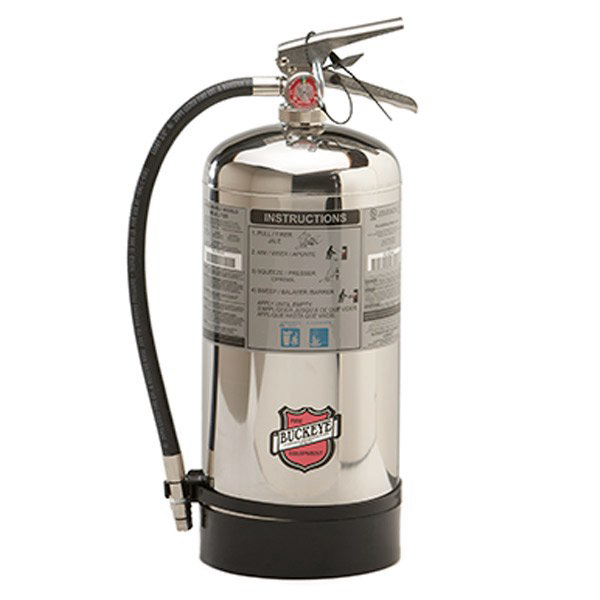 01
Apr
01
Apr
An Overview of Class K Fire Extinguishers
- 0 Comment(s)
- April 1, 2025
Fire extinguishers are key in keeping us safe from fires. They help put out small fires before they spread and cause significant damage.
However, it’s important to use the right type of extinguisher for each fire. Using the wrong extinguisher can make the fire worse. For instance, using a water fire extinguisher on a cooking oil fire can spread the flames rather than extinguishing them.
In this blog, we will look into Class K Fire Extinguishers and explain their importance in protecting life and property in commercial kitchens and other areas with cooking hazards.
What is a Class K fire extinguisher?
According to NFPA 10, Standard on Fire Extinguishers, this extinguisher effectively combats fires involving cooking oils and animal fats.
Please note that there are no numerical ratings for Class K fire extinguishers. They are tested to handle a single fire size, which is different from Class A or B extinguishers that have multiple ratings.
Why Would I Need a Class K Fire Extinguisher?
NFPA statistics show that most fires in eating and drinking establishments occur in the kitchen, particularly with cooking equipment.
Fires involving cooking oils or animal fats require Class K fire extinguishers because no other type of extinguisher can safely extinguish these fires. Most other extinguishers may fail to control the fire or potentially make it worse.
Why Aren’t Other Extinguishers Effective on Fat Fires and Cooking Oil?
Using the wrong type of extinguisher on a Class K fire can make the fire significantly worse. For example, water on a cooking oil fire can quickly cause the fire to spread.
When water turns to steam, it expands 1,600 times its original volume. This sudden expansion can cause burning oil to spread, resulting in a much larger fire or even an explosion.
One example of an extinguisher that doesn’t work well for Class K fires is a carbon dioxide (CO2) extinguisher. The CO2 will cool the top layer of the burning fuel. However, the fuel underneath retains heat and may reignite once the CO2 is used up.
Additionally, the force of the CO2 being expelled could spread the fire beyond the initial area. This issue with CO2 is not unique. Other extinguishers may also cause similar problems when used on Class K fires.
How Do Class K Fire Extinguishers Work?
Class K Fire Extinguishers use a wet chemical agent that reacts with cooking oils and fats. This chemical reaction creates a soapy media that covers the burning fuel, smothering the fire.
The process, known as saponification, occurs when the acidic (low pH) extinguisher interacts with the basic (high pH) cooking oil or fat.
Class K vs. Class B Fire Extinguishers
While both Class B and Class K Fire Extinguishers are used for flammable materials, there are key differences. Class B extinguishers are designed for flammable liquids. Meanwhile, Class K extinguishers are specifically for cooking oils and animal fats.
The major difference is in the type of fuel. Class K Fire Extinguishers are designed to deal with the thick nature of cooking oils and fats. They discharge at a lower pressure to prevent disturbing the fuel and causing it to spread.
Types of Fire Extinguishers Used for Class K Fires
Class K extinguishers typically use wet chemical agents to combat fires. To learn more about different fire extinguisher types, visit this “Fire Extinguisher Types” blog. The illustration on the right displays an NFPA 10 diagram detailing the components of a wet chemical fire extinguisher.
Optimal Placement for Class K Fire Extinguishers
According to NFPA 10, portable fire extinguishers should be installed in areas prone to fires caused by combustible cooking media, especially near deep fat fryers and other high-risk kitchen equipment.
NFPA 10 mandates that Class K fire extinguishers be positioned within 30 feet (9 meters) of areas at risk for cooking-related fires. For further guidance on proper placement, read the “Fire Extinguisher Placement Guide” article.
In commercial kitchens, the main fire protection system should be the first line of defense against fires, with fire extinguishers available as a backup. To learn more about restaurant fire protection, see the “Restaurant Fire Protection Basics” blog.
Additionally, if a Class K fire extinguisher is installed, make sure there are other extinguishers available for other types of fires. A Class K extinguisher may not be suitable for fires involving ordinary combustibles, flammable liquids, electrical fires, or combustible metals.
What Testing Is Required for Class K Fire Extinguishers?
For a fire extinguisher to receive a Class K rating, it must undergo specific testing in accordance with UL 711, the Standard for Safety for Rating and Fire Testing of Fire Extinguishers. While the testing process involves several details, the main objective is to determine if the extinguisher can suppress a vegetable oil fire in a deep fat fryer.
The extinguisher earns a Class K designation if it successfully extinguishes the fire, prevents the oil from reigniting, and prevents any splashing of flaming oil outside the fryer.
Unlike Class A or Class B fire extinguishers, there are no numerical ratings for Class K extinguishers. The result of the test is a simple pass or fail.

